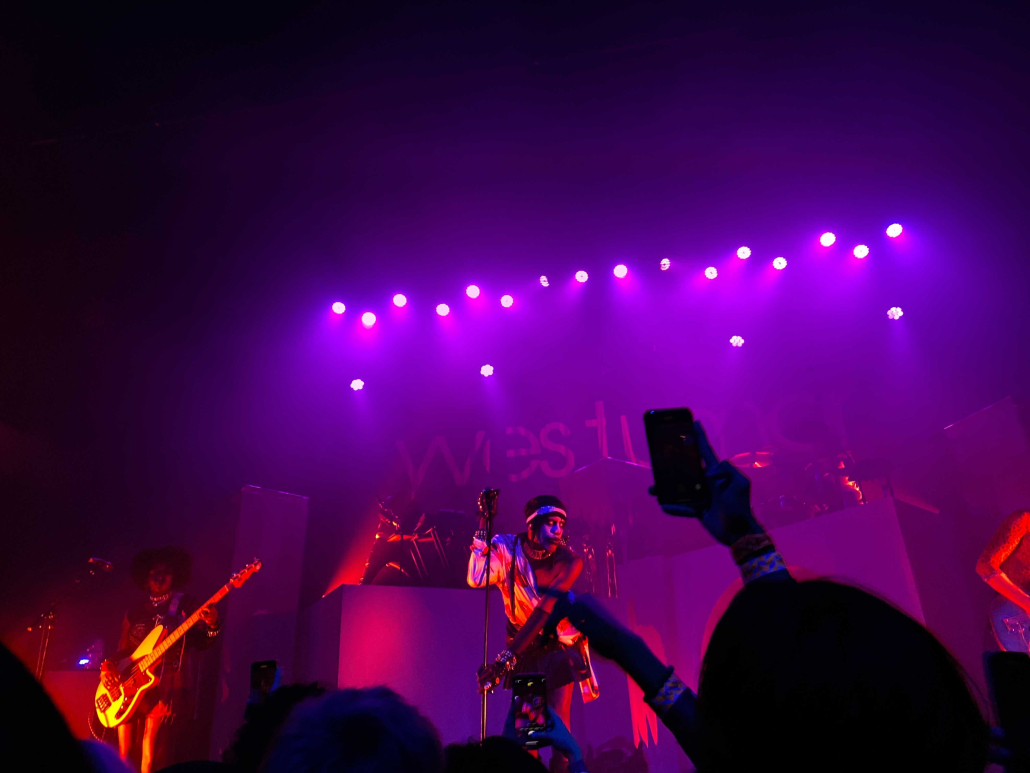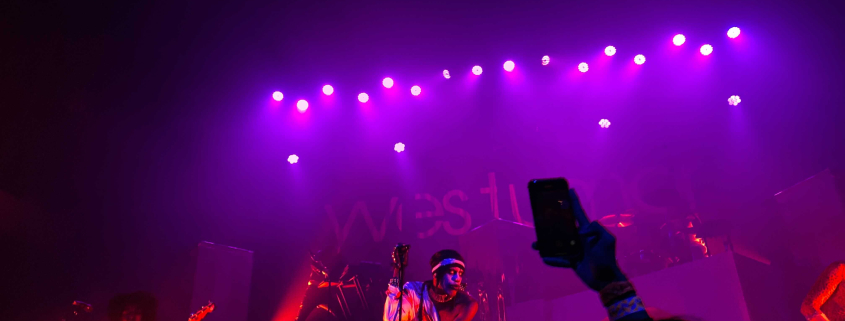Yves Tumor provides a ferocious gospel for a new generation

Amid sweltering bodies, the black-clad audience roared. After a long intermission of a trancelike, thumping beat, the audience at the Fonda Theatre in Hollywood was hungry — tantalized. As they waited, a sharp shrill of a guitar emitted behind the curtain. The curtain rose, and a tall, lanky body sauntered out.
Sold-out main act, Yves Tumor, clad in a button down shirt that revealed broad shoulders stepped onto the stage. The black skirt and boots oozed of Yves’ experimental gender-defying presence. Yet, the most shocking feature was their face. It was smothered in white powder, with black lipstick smeared on their lips and eyes. Their bright green-yellow contacts, reminiscent of snake eyes, pierced the crowd like prey.
As Yves Tumor curled their hands on the mic, the discordant and bombastic song “Gospel for a New Century” boomed, shaking their heads and arms to the pleading deep vocals. The live instrumentation translated spectacularly, chaotic and apocalyptic, as the green-haired bassist played an intoxicating bass line amid Yves Tumor’s brash begging for affection.
“This ain’t by design, girl / Take it softer / You know I’m out of my mind, girl / Don’t make this harder / Come and light my fire, baby,” sang Yves Tumor.
The energy of the audience was ignited by Yves Tumor’s pleading. The crowd was voracious, pulling and pushing itself towards the stage, sweaty bodies hurtling to the messaic figure.
Yves Tumor’s most recent album, “Heaven to a Tortured Mind,” was one of the most critically acclaimed albums of 2020. They played most of the songs on the LP, along with their latest single “Jackie” and some hits from their earlier discography.
During one of their most popular songs “Kerosene!” Yves Tumor relied on the crowd to replace Diana Gordon’s lilting crooning featured in the song with the combined shrieks and harmonies of the audience.
“Kerosene!” a sultry and smoky song about a love so fiery it becomes flammable, enthralled the audience. They slithered and shook to the soulful bass and snare — only to combust at the orgasmic climax of the song with a sharp, swirling guitar riff. Bodies collided, merged and clashed — rubbing against each other like matches striking a matchbox.
The song then slowed down to its crystalline end. Like a priest summoning his communion, Yves Tumor raised their arm up, gesturing their right hand for the crowd to give it their all for the song’s final lyrics. Another artist would have to shout to rile up their own audience. But Yves Tumor’s commanding presence spoke for itself as the crowd obeyed.
The air was thick as they lingered on the last aching note.
“Ooh, I can be what you need / I can, oh, I can, oh, I can, oh, I can, oh, I.”
At this moment, it was unsure who the crowd crooned to for this longing. Was it for Yves Tumor? For their accompanied partners? For a heavenly crush that lingered in their minds, with whom they replaced Yves Tumor’s statuesque body?
One of the most pivotal moments of the night was “Noid.” It is one of Yves Tumor’s most politically charged songs and references police brutality alongside the discordant shrill of a violin and a hip-hop charged drum beat.
“Sister, mother, brother, father / Have you, have you looked outside? / I’m scared for my life / They don’t trust us / I’m not part of the killing spree /A symptom, born loser, statistic.”
At the end, as the crowd chanted “911” along with Yves, police lights shined in and out on stage. This simple but dramatic touch cloaked Yves Tumor in a brief moment of vulnerability — a reminder that even a mesmerizing figure like Yves Tumor is still susceptible to the harms of police violence.
Despite these heavy moments, Yves never broke character. They remained an elusive and unreachable figure —except for when they entered the audience. Yves regularly came down from their luminescent pulpit to the concert floor, as if coming back down to earth.
Yves Tumor had visited the Fonda Theatre twice before, but it was intriguing how chimerical the venue could become without changing shape. They transformed this place of regality — with gilded columns and fresco-like paintings of saints and commoners — into an arena of animalistic and passionate fury.
Screw the cordiality and tradition — the crowd seemed ignited by Yves’ experimental non-conformity. It was in this crowd where you observed immense fury and anger and adrenaline.
I saw the intense — and, at times, disturbing — ferocity of moshes as bodies throttled and collided, some even falling.
However, in those moments of anarchy, there were still glimpses of beauty and community. Even when a mosh went so crazy that an individual fell, everyone who surrounded them quickly rushed to pick them up. Other quiet beauties emerged. Piercings shined in the lavender shimmer of the stage, lovers tightly embraced each other amid the tornado of whirling bodies.
It’s these extreme dichotomies that define Yves’ music, cacophonous, yet simplistic. Ethereal, but repulsive. Bass and harsh guitar command your attention, but place you in a transcendent trance.
It’s these shifting facets that keep you wanting more, and also what keeps you guessing. Who truly is Yves Tumor? What lies beyond the sweeping hips and commanding, snake-eyed stare?
It’s a question that Yves Tumor left unanswered at the end of the concert. Yet, it’s this mystery that leaves you satisfied nonetheless.

